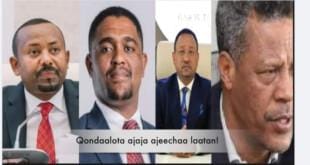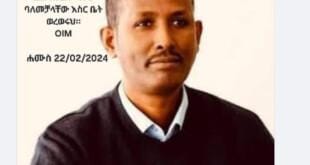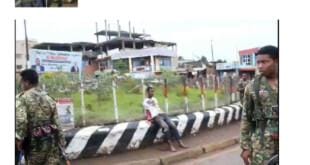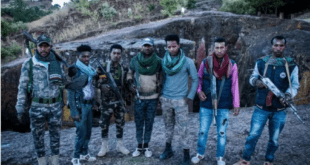*By Malkamuu Jaatee, July 2018
“No use thinking of the past for its gone, don’t think of the future because it has to come, think of the present because that’s where you are (Kazi Shams).” However, “time is the school in which we learn and the fire in which we burn (Delmore Schwartz).” Yes, time is the power house where we gain informal and formal knowledges guiding continuity of our existence on this very tiny planet in universes. Therefore, it is unwise to ignore past (history) and future (prediction) for their interconnectivity influences our intelligent capability to own success in present world (reality).
Introduction
Organization of political game to modernize governance in Ethiopia came into existence out of the early and mid-20th century movements known as peasant uprising in Wello, Tigray, Hararge, Gojjam, and Bale plus establishment of civic organization like Afran Qalloo, Mecha-Tulema, and student associations, etc. The movements were gained momentum through time and developed into socialist revolution in early 1970s. The game was not positively finalized, because the Derg regime (the military committee) violently dismantled political organizations formed during revolution. It has been brutally dictated the political fates of people of Ethiopia for 17 years depending on power emitted from external aids, mainly communist camp under leader ship of the USSR. Thus, the misdirected socialist revolution of 1974 paved way for continuation of political game in form of civil war that claimed life of millions innocent people. The 17 years (1974 – 1991) armed rebellion against the junta was developed into ethnic revolution hopped to achieve Democracy. However, it is distorted by military power of the Tigray People`s Liberation Front (TPLF) in similar fashion of the socialist revolution.
Mismanagement of the 2nd revolution resulted eruption of national revolution of Ethiopia in 2018 that attracted several stake holders competing to control it, to gain political capital almost in similar fashion of their predecessors. Multidimensional human rights violation and unfair land tenure policy imposed on rural communities of Oromia and Southern Ethiopia by the TPLF regime resulted in organization of Oromo youth (Qerroo & Qarree) movement that successfully developed into mass movement in Oromia regional state since 2012. The movement has become popular uprising in Oromia since 2014. It has clearly shown a tendency toward national movement in all parts of Ethiopia. Thus, the popular uprising of Oromo, Sidama, Amahara, Konso, Gurage, and other ethnic identities developed into national revolution of Ethiopia in February 2018. The uprising significantly forced the TPLF regime to declare two emergency states of governance within less than 2 years and finally resulted in resignation of its puppet Prime Minister (PM), Hailemariam Desalegn, on 15th of February 2018.
Thanks to almighty God, the light of freedom torched by the Oromo youth movement enabled individuals under harassment for decades, within political camp of the TPLF regime, to talk freely and act for interest of people of Ethiopia. After resignation of a puppet PM of the regime, positive political actions are significantly taking place via the leadership of new PM, Abiy Ahmed. Among many of impressive actions: thousands of political prisoners were released, the emergency law was lifted, reconciliation with any of competitive political organizations is on agenda by facilitating favourable conditions, peaceful settlement of border conflict between Ethiopia and Eritrea is on progress without preconditions, and draconian laws that limited freedom of expression and designed to label competitive political organizations as terrorist are in process to be repealed. These are indicators of positive trend towards reformation to establish democratic system of governance. However, the TPLF regime uncomfortably watches political road map leading to the reign of peace, justice, and sustainable development in Ethiopia and the horn of Africa. Because the regime has monopolized governance power for more than quarter of a century based on criminal activities stretching out in Ethiopia and beyond the border. Before answering the question stated as the tittle the atrocities committed against humanity by the regime, to monopolize apparatus (bureaucracy, diplomacy, economy, military, and politics) of governance power, are described in the following paragraphs:
- Summary of atrocities committed against humanity by the TPLF regime
The TPLF was rarely known by its real name, Marxist Leninist League of Tigray (MLLT) adopted in 1970s that rearticulated as Ethiopian People Revolutionary Democratic Front (EPRDF) in late 1980s. The EPRDF was designed by the TPLF to realize massive exploitation and subjugation of Ethiopian people via its surrogate parties known as Amhara National Democratic Movement (ANDM), Oromo People Democratic Organization (OPDO), South Ethiopian People`s Democratic Front (SEPDF), etc., respectively in Amhara, Oromia, Southern Ethiopia, and other administrative regions. These fake organizations are unconstitutionally imposed on peoples of Ethiopia through the rule of gun in violation of sovereign rights of civil people, the rights to organize and elect their own political organizations freely. The following major parameters demonstrate criminal activities of the TPLF regime: (1) multi-dimensional human rights violation to suppress descents, (2) inciting ethnic conflicts to establish unrest, (3) manipulation of governance system to carry out unlimited economic exploitation, (4) imposing extreme poverty to easily employ agents, and (5) establishment of poor quality of governance to develop rampant corruption.
The regime institutionalized crimes against humanity. It formulated and proclaimed Charities and Societies Proclamation (CSP), Anti-terrorism Proclamation (ATP), and Freedom of the Mass Media and Access to Information Proclamation (FMMAIP) to justify injustices. Thus, the constitution became political tool to protect the following criminal activities:
- The multidimensional human rights violation practices of the TPLF regime demonstrated by the following major atrocities: extra-judicial killings and massacring of several thousands of innocent civilians, disappearance of tens of thousands without trace, politically motivated decades long detention of several thousands of civilians without trial, destruction of livelihoods of millions of rural communities by forced evictions from their ancestral land, increasing refugees and internally displaced peoples, and suppressing free media.
- Orchestration and manipulation of interethnic and intra-ethnic conflicts, by the regime`s intelligence networks, have claimed tens of thousands lives and displaced millions. Its military officials are covertly involved in inciting conflicts between several rural communities to destabilize peaceful coexistence between different ethnic groups.
- Rampant corruption is developed through manipulation of rule of law, security apparatus, military force, election board, diplomatic mission, and public media. Major indicators of regime´s manipulation of governance system includes: undifferentiated legislative and executive organs, lack of transparency, distorting principle of free market in violation of civil code of conduct to control economy via its established business empire, and employing food aid as a tool to gain and protect political support.
- Development of extreme poverty during governance era of the TPLF regime is manifested by: millions of people became victims of chronic food insecurity and unsafe drinking water, poor status of human health, reduction to the status of forced manual laborer via land grabbing, financial disability to access basic needs, and categorization of Ethiopia among the 15 countries with the lowest human development indices in the world.
- Very poor quality of governance of the regime demonstrated by suppression of alternative voice, lack of accountability, political instability, ineffective governance, void system of regulation, no respect for rule of law, and rampant corruption.
The TPLF regime violated human rights in similar paths of its predecessors, monarchy (before 1974) and communist (1974 to 1991) regimes. All of them negatively reacted to the aspirations and expectations of majority of the people of Ethiopia. They invested their energy on systematic genocide to protect the status quo of zero-sum political game. The losers in the game have lost everything including their life during the three last regimes of Ethiopia: for examples (1) the fate of prince Iyasu under emperor Haile Silase; (2) several thousands of members and supporters of Ethiopian People’s Revolutionary Party (EPRP), All-Ethiopia Socialist Movement (AESM), Marxist–Leninist Revolutionary Organization (MLRO), Ethiopian Oppressed People’s Revolutionary Struggle (EOPRS), and Labour League (LL) were murdered by Revolutionary Flame (RF) called “the Derg” and its revolutionary guards under command of colonel Mangistu Hailemariam; and (3) several thousands of Oromo civilians as suspected members and supporters of Oromo Liberation Front (OLF) were extra judicially killed by the TPLF regime under command of PM Meles Zenawi. The regimes were finally overthrown by very expensive civil war and popular uprising claimed millions of innocent lives. Transition from exclusive to inclusive governance politics requires commitments of both government and competitive parties. The progressive movement to democratize governance in Ethiopia will probably be crippled by the following three major negative forces: Fragmentation of competitive parties, Poverty, and Terrorism.
- Negative forces limiting success of movement towards democratization of Ethiopia
Fragmentation of competitive parties along political interpretation of citizenship, democracy, federation, freedom, national identity, and self-determination make them incapable to establish formidable alliance. The size of organizations and contradiction between them based on shallow ideological difference related to meanings of political words make their business inefficient to positively contribute for success of transition to democracy. Number of political parties were less than 10 during 1970s and 1990s, however it increased exponentially after 1992. Data of Ethiopian political parties currently show list of more than 50 organizations. To overcome inefficiency, the alliances like: Union of Liberation Fronts of Oromia (ULFO 2000), Coalition for Unity and Democracy (CUD 2004), United Ethiopian Democratic Forces (UEDF 2005), Alliance for Freedom and Democracy (AFD 2006), Unity for Democracy and Justice (UDJ 2008), People’s Alliance for Freedom and Democracy (PAFD 2016), and Ethiopian National Movement (ENM 2016) were established. However, none of the alliance became effective, because their leaders follow foot print of the zero-sum game of their predecessors.
Poverty affects process of transition from dictatorship to democracy in two forms: catalyst of conflict leading to vicious cycle of civil war and a market of political support for dictators. The TPLF regime has increased number of peoples living in poverty through high level of income disparity. Extremely large gab of income is established with illegal accumulation of excessive wealth in hands of the regime`s elites and families via unconstitutionally organized fake nongovernmental institutes and expanded business empires. Increasing number of peoples living in chronic poverty is hidden strategy to limit the ability of Ethiopian people to positively change governance power from dictatorship to democracy. Thus, humanitarian organizations involvement in struggle against poverty is crippled by employing politically motivated proclamations, CSP & ATP. Integration of social, economic, & political dimensions of struggle against poverty is essential to realize sustainable development. Respect for human rights and governance quality are synergistically influence the success of political struggle to reduce poverty. Multidimensional activities of humanitarian organizations contribute positively in reduction of poverty; however, their participation is limited to protect political strategy of the TPLF regime. Real reduction of poverty is uninteresting business for the regime, because poverty is a political tool to buy supporters, for example through micro credit and food aid services. Thus, the regime will employ poverty to organize criminal activities to destabilize the transition from undemocratic to democratic governance. The possibility to buy individuals and organize them covertly, via regime`s secret networks deep rooted into local level, to establish unrest is inevitable. The regime is behind the recent large-scale interethnic conflicts taking place in Eastern, Southern, and Western Ethiopia since 2015.
Terrorism is the 3rd factor possibly hinder the process of establishing inclusive and representative government in Ethiopia. The TPLF regime may use its long experience of terrorist activities to destabilize the country. The regime has effectively utilized terrorism as a tactical tool to ascend the government power via rebellion (1974 -1991) and to protect its state power monopolies (1991 – 2018). It has frequently carried out terrorist activities and blamed on the competitive political parties mainly the OLF and the ONLF. The dramas of terrorist incidents were hiddenly designed and executed through secret networks of the regime to justify extrajudicially killing several thousands of innocent Oromo and Somali civilians. This evil tactic crossed the border of the country and became a destructive force jeopardising peace and stability of the Horn of Africa. No one is more responsible than the TPLF and its military officials for destabilization of Somalia. The covert partnership between the regime and the Alshebab (Islamic militant) via lucrative business of military equipment makes difficult the eradication of international terrorist from the region. Thus, the regime may reorganize underground through its established secret networks to carry out medium scale terrorist activities to destabilize the healthy movement towards democratization. For example, grenade bomb explosion at Meskel square in Addis Ababa on 26th of June 2018, against the public rally that support reformation agenda of PM Abiy, seems a signal of the beginning of new era of terrorism in Ethiopia.
- Way forward to convert threats to opportunity
Establishment of peace and reconciliation plat-forms at all levels (district, province, and national) with involvement of major stakeholders mainly the government, competitive political parties, leaders of religions, traditional leaders of different ethnic groups, and intellectual societies are required to minimize those risks potentially destabilize the progressive movement towards democratization. Without holistic approach, it is difficult to tackle systematic obstacles hindering half a century struggle of peoples of Ethiopia to attain its main goal: establishment of government of the people, by the people, for the people. The zero-sum game is still active in camps of government and competitive political parties. The way forward should be drawing lessons from errors of predecessors to shift from mentality spoiled by exclusiveness to attitude reconstructed by humbling inclusiveness. Thus, the losers should not loss everything to stabilize the playing field to successfully establish new Ethiopia where peace, justice, freedom, democracy, and sustainable development reign under the rules of law.
Conclusion
Without self-liberation from the cult of ego and selfish personality carried over from monarchy to Derg and from Derg to the TPLF regime, it seems remote to finalize expensive political game running for more than 50 years. Even though devil is behind any political game, genuine partnership and alliances of all stake holders are key for success.
“And we know that in all things God works for the good of those who love him, who have been called according to his purpose (Romans 8:28).”
References
- Academic Dictionaries and Encyclopaedias 2017. List of political parties in Ethiopia. Accessed from the website on 15. 07. 2018. http://enacademic.com/dic.nsf/enwiki/231872
- Acemoglu D. and Robinson J. A., 2012. Why nations fail, the origins of power, prosperity, and poverty. Profile book LTD, 3A Exmouth House, Pine street, London
- Berhe K. 2005. Ethiopia: democratization and unity: The role of the Tigray People`s Liberation Front. Münster: Verlagshaus Monsenstein und vannerdat OHG.
- Jaatee M. and Anywaa Survival Organization, 2016. Land Grabbing and Violations of Human Rights in Ethiopia. http://genocidewatch.net/2016/02/01/land-grabbing-in-ethiopia/ Accessed from the website on 15. 07. 2018.
- Mulataa. Z., 2010. Political nongovernmental organizations and governmental companies in Ethiopia. Political roles of local NGOs & governmental companies under the ownership of TPLF/EPRDF regime. Accessed from the website on 15. 07. 2018. http://www.oromoliberationfront.org/news/2010/Fake_NGO_of_the_TPLF_(gullaala_xummuraa)[1].pdf
- Mulataa Z. 2010. Antidemocratic system of governance in Ethiopia under absolute dictatorship of TPLF regime. Accessed from the website on 20. 07. 2018. http://www.ethiomedia.com/absolute/anti_democratic_governance_in_ethiopia.pdf
- Oromia Support Group (OSG), 2010. Submission from Oromia Support Group, Human Rights Committee in its 99th session 12-30 July 2010, Geneva. Accessed from the website on 18. 07. 2018. https://www.ecoi.net/file_upload/470_1283946253_osg-ethiopia-hrc99.pdf
- United Nations Development Programme, 2016. Human Development Report 2016. Accessed from the website on 18. 07. 2018. http://hdr.undp.org/sites/default/files/2016_human_development_report.pdf
- Unpublished Running Document (URD), 2002. Ethiopian non-governmental business: companies controlled by or associated with EPRDF-member organizations (4th update of a running documentary).
- Wikipedia 2016. Union of Ethiopian Marxist–Leninist Organizations. Accessed from the website on 20. 07. 2018. https://en.wikipedia.org/wiki/Union_of_Ethiopian_Marxist%E2%80%93Leninist_Organizations




